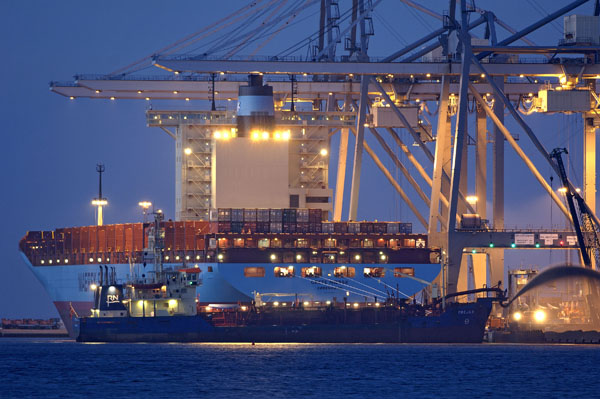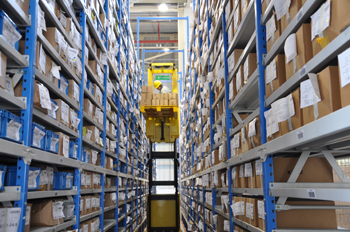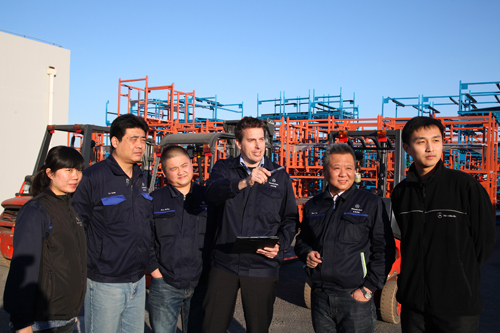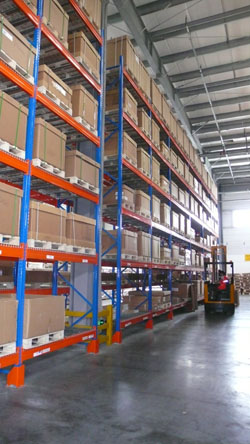 With increased local production still relying heavily on imported material, supply chain efficiency in planning, customs, shipping and packing is crucial to succeeding in China
With increased local production still relying heavily on imported material, supply chain efficiency in planning, customs, shipping and packing is crucial to succeeding in China
As the largest automotive market in the world, on pace to build and sell nearly 23m vehicles in 2014, China has a strong and growing domestic supply base for parts. Some foreign brand joint ventures, including certain models built by FAW-Volkswagen and Shanghai Volkswagen, have content localisation rates as high as 95%, according to Ursula Schulte, director of logistics at Volkswagen Group China. As the country’s automotive sector develops in terms of technology and quality, carmakers and tier suppliers are sourcing more of their production parts within China to save both lead time and costs.
However, with a large share of its growth in foreign brands, as well as increasing production of premium-brand vehicles from Europe, the US and Japan, many of China’s car factories rely heavily on imported material for production, as well as for spare part demand in the aftermarket. For example, the launch in recent months of the Chery Jaguar Land Rover plant outside
- Feeding local production
- LCVs at Fujian Benz
- Direct delivery to Beijing Benz
- VW improves pack density
- A role for 3PLs and rail
See also
- Mapping Chery JLR's supply chain
- Tier ones look to reusable packaging
Shanghai, which produces a local version of the Range Rover Evoque (called the ‘Aurora’ in China), will include a heavy proportion of imported material, at least early on. Other companies, including Volkswagen’s joint venture production of Audi vehicles, and Mercedes-Benz’s of passenger and light commercial vehicles, also have a significant reliance on European and global material. Likewise, a localised tier one supplier in China may still import certain critical components from its overseas operations or tier two suppliers.
Indeed, China’s rising production is leading to a higher volume of imported parts overall, even if the percentage of imported material goes down for most products.
As a result, manufacturers are looking for ways to make the process of consolidating and importing foreign material more efficient. It’s a process that requires attention across the supply chain, from order planning in Chinese and foreign plants, to container shipping, customs and packing operations. Carmakers, together with their logistics providers, have made efforts to rationalise warehousing in Europe, for example. Better packaging design and part consolidation have also enabled some manufacturers to improve their container-fill rates for material exported to China. Other carmakers, notably Daimler, are interested in the potential for returnable and reusable packaging for these global flows.
Foreign supply chains are, of course, often at the mercy of disruption and unpredictable lead times. However, executives at manufacturers and logistics providers point to even longer shipping times resulting from container lines’ ‘slow steaming’ practices. Air freight is therefore an important alternative to help catch up demand or prevent plant shutdowns. Third party provider Gefco China, for example, has introduced a new air freight service between France and Wuhan, where PSA has joint venture production with Dongfeng, through which Gefco has shortened the international transit time.
Long-distance rail freight, connecting Europe and Russia to China via Central Asia and the Trans-Siberian railway, is also of interest to logistics providers and manufacturers as an alternative to more costly air freight or, in some cases, for regular flows to replace slower sea freight. This is an area that China’s government has been promoting. Providers including Gefco and DB Schenker offer the service; Changjiu Logistics and Uti have also announced they will move automotive freight along the route.
An end-to-end approach at Fujian Benz
Improving logistics efficiency involves making changes at both the origin and destination regions. One company that has done so in a comprehensive manner is LCV-manufacturer Fujian Benz Automotive Company (FBAC), based in Fuzhou, southeast China. FBAC is a joint venture between China’s Fujian Motors Group, Taiwan’s China Motor and Daimler. According to the company’s logistics director, Shuier Huang, most of FBAC’s parts originate in Europe; while the company has been increasing its parts localisation, it has also placed a major focus on improving its import supply chain.

An FBAC third party logistics provider handles trucking from the consolidation point to the port and is responsible for shipping containers by ocean. Containers ship via Bilbao, which is located near to Vitoria.
Vessel frequency is weekly through the port of Mawei, in Fuzhou. Most containers are drayed directly from the port to the plant, while some containers move from the port to FBAC’s leased warehouse before moving onto the plant. Huang says the lead-time is usually about 40-50 days from Europe to China, not including customs clearance time.
FBAC uses air freight for urgent orders and for meeting increased demand. “Currently, we ship about 4% of our
parts by air freight. Most air freight is for urgent shipments of normal parts if the market receives increased orders. We also use air freight regularly for some consumable parts,” explains Huang.
One notable change the company made was switching shipping incoterms to FCA in order to take control of international logistics directly. The change, according to Huang, allowed FBAC to choose and define its freight forwarding more freely. “Within the past year, we have changed our shipping terms from CIF to FCA, through which we can save about ten days shipping time, make the process more stable and better manage our 3PL provider,” he says.
Within Europe, the company has also worked with Daimler to improve container-loading rates and storage costs. “Previously, the container-loading rate was about 60-70%. After optimisation between Daimler and FBAC, the rate is now about 85-92%,” reports Huang.
To reduce trucking and storage costs, FBAC and Daimler have combined consolidation centres in Düsseldorf and Vitoria to only one in Vitoria in late 2013.
Packaging is also a priority. At the Vitoria warehouse, FBAC currently uses mainly plastic boxes, carton boxes, racks, and standard and special containers. All of its packaging ships one-way only, which Huang admits is costly and is something that the company would like to address.
“We need to use reusable instead of one-way packaging in order to reduce our high packaging costs. Furthermore, we will consider increasing the part quantity per box, omitting redundant packing materials, for example,” says Huang.
Finally, with the help of a consultant, FBAC reduced its safety stock by one week, on average, which has helped to shorten shipping times as well as reduce inventory and air freight costs. “By managing a reasonable safety stock, we were able to reduce inventory costs and air freight costs. The shipping time has shortened and become more stable,” says Huang.
Meeting growing local production demands for Beijing-Benz
Imported material content is also important at another Daimler joint venture, Beijing Benz Automotive Company (BBAC), which builds passenger cars in China. Florian Hohenwarter, vice-president of logistics at Daimler China points out that Mercedes-Benz local production volume in China is increasing, which drives more imported parts. “By 2015, we expect at least two-thirds of our Chinese sales volume to come from our Beijing-based production lines,” says Hohenwarter.
Indeed, according to Daimler’s current plans, BBAC is destined to become the biggest Mercedes-Benz passenger car plant in the world, with a footprint as large as the company’s two German main production hubs in Sindelfingen and Untertürkheim, points out Hohenwarter. The company plans to have invested €4 billion ($5 billion) by the end of 2015.
Daimler, which manages consolidation and export operations to its joint venture, exports hundreds of sea containers each week to BBAC, via a standard route from the port of Bremerhaven, Germany, to the port of Xingang (Tianjin) in China. The total delivery time is about six weeks, says Hohenwarter. There is also air freight of certain goods from Frankfurt to Beijing.
Along with these routes, Daimler has successfully implemented direct deliveries to BBAC for suppliers to China from outside Europe, such as from Japan, which prevents wasteful consolidation in Europe before returning back to Asia.

As at FBAC, Hohenwarter points to container fill rates and the exploration of more returnable packaging. “One of our main areas of focus is to increase the container fill rate in order to reduce transportation costs. Another is to investigate ways to change from one-way-packaging to returnable racks in order to save on handling and packaging costs,” he explains. “Growing in a new market requires an unprepossessing approach and proactive thinking.”
To improve container fill rates, Daimler has looked to redesign its packaging and handling operations. “We implemented measures such as the optimisation of package sizes and the mixing of unloading points in containers,” says Hohenwarter.
To manage the entire chain in a more integrated way, including across Daimler and BBAC entities, Daimler has installed a liaison office for international inbound logistics on-site at BBAC, which acts as an interface between Daimler in Germany as shipper, BBAC in China as consignee, and finally for the external logistics service provider.
These changes have helped Daimler to improve its logistics efficiency in terms of quality, time and cost. For example, switching to high-cube containers enabled it to reduce its transport costs not only for imported parts, but also for internal handling operations, according to Hohenwarter. “Furthermore, our stable delivery quality enabled us to gain the AA certificate from Chinese customs. This will result in shorter throughput time and reduced inventory,” he says.
Geographic expansion for Volkswagen
The Volkswagen Group operates eight joint venture vehicle assembly plants in China, including three for FAW-Volkswagen and five for Shanghai Volkswagen (SVW). There are also joint venture component plants. Most of the factories are located on the east coast or south coast, although its footprint is expanding, including plans for an SVW plant in Changsha, 1,100km southwest of Shanghai. SVW also has a plant in the far west of China in Urumqi, the capital of the Xinjiang Uyghur Autonomous Region, 4,000km from Shanghai. FAW-VW opened a plant in Chengdu in 2011 and in 2014 began production in Foshan, in Guangdong province.
According to Schulte, the Volkswagen Group imports parts using the ports of Dalian, Shanghai and Hong Kong. Once the containers have cleared customs, they move by various modes to warehouses located near the plants: by truck from Shanghai and Hong Kong, by rail from Dalian, and by barge from Shanghai to Chengdu.
The Volkswagen Group also imports finished vehicles, including the Audi brand, through the ports of Tianjin, Dalian and Guangzhou; Schulte says this number is fewer than 300,000 units per year.
While the company tries to avoid imports wherever possible, Schulte adds that the company is also targeting shipments by full container load and to improve pack density.
Transport alternatives
Third party logistics providers play an important role in improving shipments to China. Schenker China, a division of Germany’s DB Schenker, provides ocean, air and multimodal transport solutions. DB Schenker also provides customs clearance, storage and just-in-time plant deliveries from its warehouses in China.
Like DB Schenker, 3PL provider Gefco offers comprehensive services on both the export and import sides for China-bound shipments. Gefco operates at coastal ports for sea freight to China and at the main international air hubs in Beijing, Shanghai and Hong Kong for air freight. Gefco imports around 70% of its automotive parts by ocean and 30% by air, according to Andrea Ambrogio, Gefco China’s managing director. The split between production and aftermarket parts is similar, with 70% being for production and 30% for service parts.

Volkswagen’s Schulte agrees, saying that slow steaming has added about a week in transit time from Europe to China.
As an alternative to ocean transport, Wildt says rail is a growing mode that is faster and potentially more reliable for shipments from Europe to China. Schulte says the Volkswagen Group began to use rail within the past two years as part of block train services out of Europe. BMW has also used the service with some regularity between Germany and its plants in northern China for a number of years. Schulte says sea transport takes 13 weeks total lead-time, including planning, while rail takes two to three weeks; however, she says, it is much more expensive than ocean transport.
Gefco, majority-owned by RZD Russian Railways, which owns and operates large sections of the railway link between Europe and China in Russia, has also been pushing rail solutions between China, Russia, Central Asia and Europe. Gefco uses a rail hub in Chongqing and inland waterway ports to transport cargo to the sea and air hubs. “China is suited to multimodal transportation given its geography,” says Ambrogio. “For example, the central government has been promoting rail development. We foresee increasing rail flows between Europe and China, which will help to increase the efficiency of overland logistics services.”
In August, Gefco transported finished vehicles from Germany to China via the Xinjiang-Chongqing rail route, which runs through northwest China to Chongqing in the southwest. Ambrogio says the Europe-China block train service offers great potential for OEMs to improve the transport of vehicles. Gefco has also run a number of other trials for OEMs along the route, including for spare parts.
However, it is not clear that rail will ever carry a large share of imported automotive material for China. While Volkswagen uses the route, it currently represents a very low percentage of imported parts, says Schulte. The advantage for rail is obviously its speed, but in most cases this is not enough to make up for the cost difference with ocean shipping.
“Even considering the slower speed, with reliable capacity, ocean transport is cheaper than rail. It is also safer than rail, due to theft problems,” Schulte says.
"China is suited to multimodal transportation given its geography. We foresee increasing rail flows between Europe and China" - Andrea Ambrogio, Gefco China
Nevertheless, OEMs have expressed interest in the route. Alex Holland, a logistics manager for Chery Jaguar Land Rover, says the prospect of connecting rail closer to Shanghai, rather than only in the northeast or west of the country, would make it even more interesting. He points to more companies, including Chinese logistics providers, who are offering more services along the route.
This is certainly an interest that could prompt more diversity of services across the international supply chain for China. Gefco’s Ambrogio notes that carmakers in the country are increasingly looking beyond their own logistics subsidiaries and group providers, which creates more room for independent and foreign 3PLs and 4PLs to offer services. He believes that the increasing competition will also improve logistics efficiency across China’s automotive supply chain.
In the meantime, however, efforts by FBAC, Daimler and Volkswagen to increase container fill rates and package density show there is still plenty of potential to improve existing flows. Although China’s sales and production growth looks set to be slower than it has been over the past five years, the increase in production among foreign brand joint venture OEMs is likely to continue to pull higher parts imports from across the globe. With that, the interest in faster, more efficient logistics services for international flows will only rise too.

























![Global[1]](https://d3n5uof8vony13.cloudfront.net/Pictures/web/a/d/s/global1_726550.svgz)









